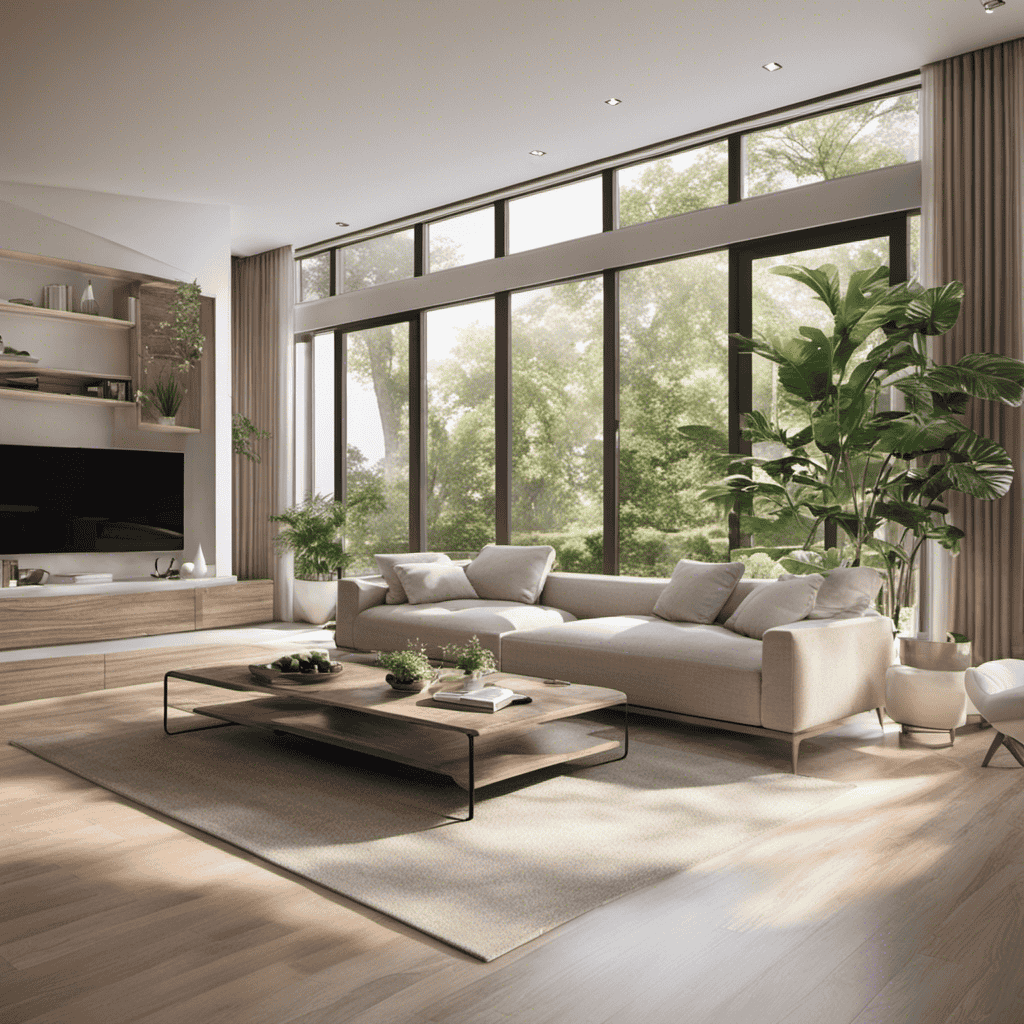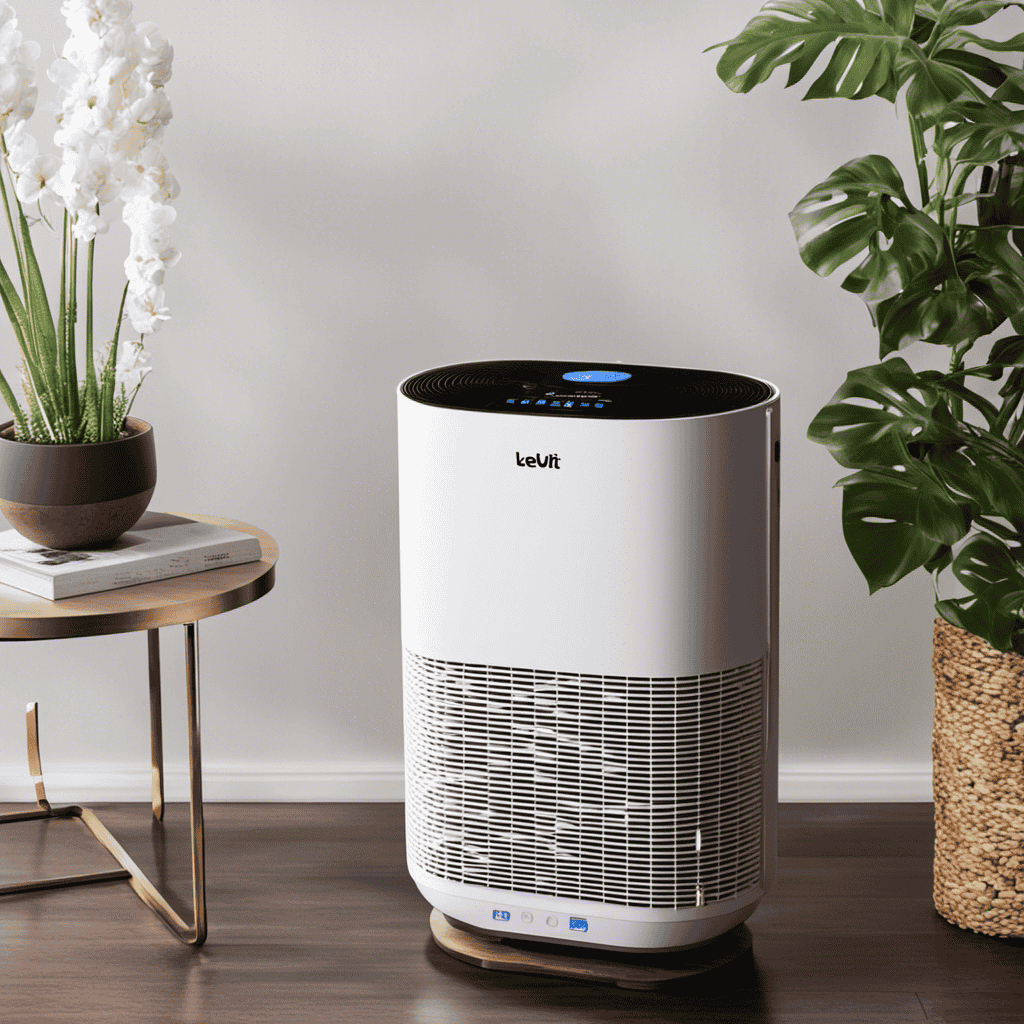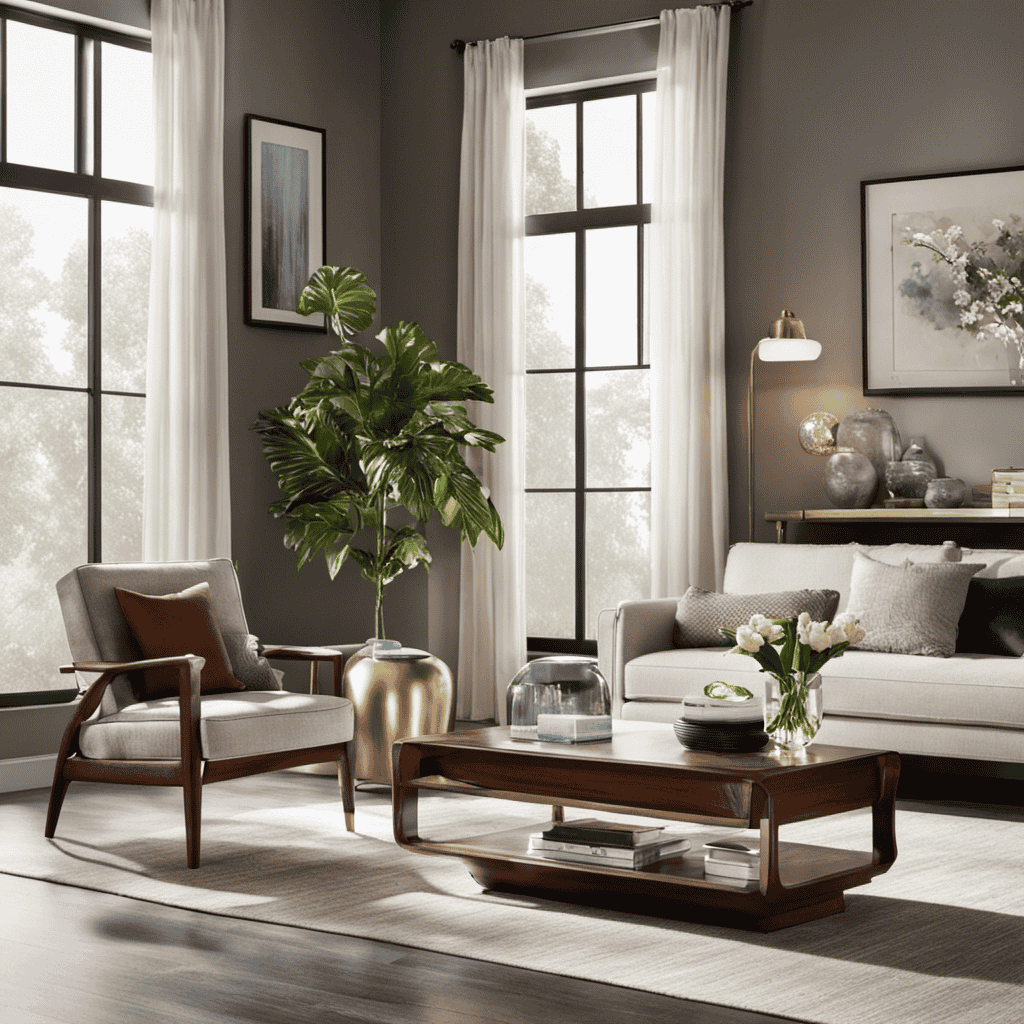You may have heard the phrase, ‘It’s better to be safe than sorry.’ When it comes to using your air purifier, it’s crucial to understand the ideal duration for running it.
In this article, I’ll guide you through the factors to consider when determining the ideal running time for your air purifier. From room size to health benefits and energy efficiency, we’ll cover it all.
So, let’s dive in and find out the best practices for keeping your air clean and fresh.
Key Takeaways
- The ideal running time of an air purifier depends on factors such as room size, air quality, noise level, energy consumption, and cost of replacement filters.
- Adjusting the running time according to the room size can ensure efficient air cleaning without excessive energy consumption. Recommended running times for different room sizes are: small (up to 150 sq ft) – 1-2 hours, medium (150-300 sq ft) – 2-4 hours, large (300+ sq ft) – 4-8 hours.
- Energy efficiency considerations include setting a timer, using lower fan speeds, cleaning or replacing filters regularly, and matching the air purifier size to the room.
- Maintenance and filter replacement are important for optimal performance and clean air quality. Following the manufacturer’s recommendations, vacuuming or washing filters, and using quality filters can improve efficiency and maintain high-quality air output.
Factors to Consider
When deciding how long to let your air purifier run, you should consider factors such as the size of the room and the air quality in your environment.
Noise level considerations are also important. Some air purifiers can be quite loud, which might be disruptive if you plan to use it in your bedroom or office. Look for models that have a noise level rating of 50 decibels or less for a quieter operation.
Additionally, it is crucial to conduct a cost effectiveness analysis. Consider the energy consumption of the air purifier and the cost of replacement filters. Some air purifiers have energy-saving features and reusable filters that can help reduce operating costs.
Ideal Running Time
To maximize its effectiveness, it’s recommended to run your air purifier for several hours each day. Here are four reasons why this optimal duration is important:
-
Efficient Air Cleaning: Running the air purifier for several hours ensures that it has enough time to effectively clean the air in your space. This allows it to remove pollutants, allergens, and other harmful particles, resulting in cleaner and healthier air for you to breathe.
-
Continuous Filtration: Longer running times ensure continuous filtration, which is crucial for maintaining a high level of air quality. By running the air purifier for several hours, you can ensure that the air is constantly being filtered, reducing the chances of pollutants settling and re-circulating in the room.
-
Enhanced Allergen Control: Air purifiers can be particularly beneficial for individuals with allergies. Running the purifier for several hours helps to capture and remove allergens from the air, providing relief from common allergy symptoms.
-
Impact on Electricity Consumption: While longer running times are beneficial for air quality, they can also impact electricity consumption. It’s important to consider the energy efficiency of your air purifier and find a balance between optimal running time and electricity usage.
Adjusting for Room Size
Running your air purifier for shorter durations can be more suitable for smaller rooms, as it ensures efficient air cleaning without excessive energy consumption. When it comes to room size adjustment, it’s important to consider the effectiveness of your air purifier. A smaller room requires less time for the air purifier to circulate and clean the air. To help you understand the recommended running time for different room sizes, here is a table that provides a general guideline:
| Room Size | Recommended Running Time |
|---|---|
| Small (up to 150 sq ft) | 1-2 hours |
| Medium (150-300 sq ft) | 2-4 hours |
| Large (300+ sq ft) | 4-8 hours |
Health Benefits of Extended Use
I’ve found that extended use of an air purifier can greatly improve indoor air quality, leading to a healthier living environment.
Not only does the air purifier help to remove dust, pollen, and other allergens from the air, but it can also provide relief for those suffering from allergies and asthma.
Increased Indoor Air Quality
You’re likely to experience improved indoor air quality by using an air purifier regularly. Here are four reasons why clean air is beneficial:
-
Reduction of airborne pollutants: Air purifiers are designed to filter out harmful particles such as dust, pollen, pet dander, and mold spores. By removing these pollutants from the air, you can breathe easier and reduce the risk of respiratory issues.
-
Allergy and asthma relief: Clean air can provide relief for those suffering from allergies or asthma. By removing allergens and irritants from the air, air purifiers can help alleviate symptoms and improve overall respiratory health.
-
Improved sleep: Breathing clean air can lead to better sleep quality. Air purifiers can remove airborne particles that may disrupt sleep, ensuring a restful and rejuvenating night’s rest.
-
Enhanced overall well-being: Breathing clean air has numerous benefits for your overall health and well-being. It can boost your immune system, reduce the risk of respiratory infections, and improve cognitive function.
Investing in an air purifier is a worthwhile decision for improving your indoor air quality and reaping the many benefits of clean air.
Allergy and Asthma Relief
By regularly using an air purifier, you can experience relief from allergies and asthma due to the removal of allergens and irritants from the air.
Air purifiers are highly effective in reducing airborne contaminants that trigger allergy and asthma symptoms. These devices work by filtering out particles such as dust, pollen, pet dander, and mold spores, which are common triggers for allergies and asthma.
The air purifier’s filtration system captures these particles, preventing them from circulating in the air and causing respiratory problems.
With the continuous operation of an air purifier, you can create a cleaner and healthier indoor environment, providing relief for those suffering from allergies and asthma.
It is important to choose an air purifier with a HEPA filter, which is known to be highly effective in removing airborne allergens and irritants.
Energy Efficiency Considerations
Running your air purifier continuously may increase your energy bill. However, there are some cost-saving tips to consider when it comes to the energy efficiency of your air purifier. Here are four important things to keep in mind:
-
Set a timer: Most air purifiers come with a timer feature that allows you to set specific operating hours. By using this feature, you can reduce the amount of time the air purifier runs and save on electricity costs.
-
Use lower fan speeds: Many air purifiers have multiple fan speed settings. Using a lower fan speed not only reduces noise levels but also consumes less energy.
-
Clean or replace filters regularly: Dirty or clogged filters can make your air purifier work harder, leading to increased energy consumption. Regularly cleaning or replacing filters will ensure optimal performance and energy efficiency.
-
Consider the size of the room: If you have a smaller room, using a smaller air purifier can be more energy-efficient. Matching the size of the air purifier to the room will prevent unnecessary energy usage.
Nighttime Operation
Using a timer feature on your air purifier can help reduce energy consumption during nighttime operation. This is especially important because running the air purifier all night can contribute to increased energy usage and higher electricity bills. Additionally, excessive noise from the air purifier can disrupt your sleep and impact the overall quality of your rest. By setting a timer to turn off the air purifier after a certain amount of time, you can ensure that it runs for an adequate period to clean the air in your room, but also avoid wasting energy and disturbing your sleep. Consider using the table below to compare different air purifiers and their timer features to find one that suits your needs.
| Air Purifier Model | Timer Options | Noise Level |
|---|---|---|
| Model A | 1 hour, 2 hours | Low |
| Model B | 4 hours, 8 hours | Medium |
| Model C | 6 hours, 12 hours | High |
Maintenance and Filter Replacement
It’s important to regularly maintain and replace the filters in your air purifier to ensure optimal performance and clean air quality. Here are some key steps to follow:
-
Check the manufacturer’s recommendations: Each air purifier model may have specific guidelines for filter replacement and maintenance. Be sure to consult the user manual for accurate information.
-
Regular cleaning: Dust and debris can accumulate on the filters, reducing their effectiveness. Vacuuming or washing the filters can help remove these particles and improve the purifier’s efficiency.
-
Filter replacement schedule: Filters have a lifespan, and it’s essential to replace them according to the manufacturer’s instructions. This ensures that the purifier continues to function properly and provide high-quality air.
-
Use quality filters: Investing in high-quality replacement filters can significantly impact the performance and longevity of your air purifier. Look for filters that are designed to capture a wide range of pollutants and have a longer lifespan.
What is the recommended run time for an air purifier to effectively clean the air?
The recommended running an air purifier duration varies depending on the size of the room and the purifier’s capacity. Generally, running an air purifier for 8-12 hours a day can effectively clean the air in a standard sized room. Larger spaces may require longer run times for optimal air purification.
Frequently Asked Questions
Can I Use My Air Purifier in Multiple Rooms?
Sure, you can use your air purifier in multiple rooms. It’s portable, so you can easily move it around. Just keep in mind that running it in different rooms may increase maintenance costs.
What Are the Potential Health Risks of Using an Air Purifier for an Extended Period of Time?
Using an air purifier for extended periods may have potential side effects due to long term exposure. It’s important to be aware of the risks and follow manufacturer guidelines to ensure safe usage.
How Often Should I Clean the Filters of My Air Purifier?
I clean the filters of my air purifier every month to maintain optimal performance. Regular cleaning helps remove dust and allergens, ensuring cleaner air. It’s an important part of maintenance to keep the purifier running efficiently.
Can Air Purifiers Help With Allergies and Asthma?
Air purifiers can be beneficial for allergies and asthma. They can help remove allergens and irritants from the air, such as pet dander and smoke particles. Regular use can provide relief and improve air quality.
Are There Any Safety Precautions I Should Take When Using an Air Purifier?
When it comes to using an air purifier, it’s important to take safety measures and follow proper maintenance tips. By doing so, you can ensure the optimal functioning and longevity of your device.
Conclusion
In conclusion, when it comes to running your air purifier, the longer, the better! Let that baby hum all day and night, filtering out those pesky pollutants with gusto.
Don’t worry about your energy bill, because the benefits to your health far outweigh any cost concerns.
So, crank up that purifier and breathe in the cleanest air imaginable. Trust me, you’ll feel like you’re floating on a cloud of freshness.
Happy purifying!










